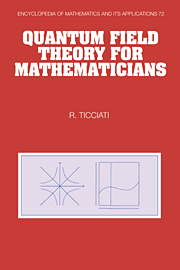Book contents
- Frontmatter
- Contents
- Preface
- Introduction
- 1 Relativistic Quantum Mechanics
- 2 Fock Space, the Scalar Field, and Canonical Quantization
- 3 Symmetries and Conservation Laws
- 4 From Dyson's Formula to Feynman Rules
- 5 Differential Transition Probabilities and Predictions
- 6 Representations of the Lorentz Group
- 7 Two-Component Spinor Fields
- 8 Four-Component Spinor Fields
- 9 Vector Fields and Gauge Invariance
- 10 Reformulating Scattering Theory
- 11 Functional Integral Quantization
- 12 Quantization of Gauge Theories
- 13 Anomalies and Vacua in Gauge Theories
- 14 SU(3) Representation Theory
- 15 The Structure of the Standard Model
- 16 Hadrons, Flavor Symmetry, and Nucleon-Pion Interactions
- 17 Tree-Level Applications of the Standard Model
- 18 Regularization and Renormalization
- 19 Renormalization of QED: Three Primitive Divergences
- 20 Renormalization and Preservation of Symmetries
- 21 The Renormalization Group Equations
- Appendix
- References
- Index
14 - SU(3) Representation Theory
Published online by Cambridge University Press: 31 October 2009
- Frontmatter
- Contents
- Preface
- Introduction
- 1 Relativistic Quantum Mechanics
- 2 Fock Space, the Scalar Field, and Canonical Quantization
- 3 Symmetries and Conservation Laws
- 4 From Dyson's Formula to Feynman Rules
- 5 Differential Transition Probabilities and Predictions
- 6 Representations of the Lorentz Group
- 7 Two-Component Spinor Fields
- 8 Four-Component Spinor Fields
- 9 Vector Fields and Gauge Invariance
- 10 Reformulating Scattering Theory
- 11 Functional Integral Quantization
- 12 Quantization of Gauge Theories
- 13 Anomalies and Vacua in Gauge Theories
- 14 SU(3) Representation Theory
- 15 The Structure of the Standard Model
- 16 Hadrons, Flavor Symmetry, and Nucleon-Pion Interactions
- 17 Tree-Level Applications of the Standard Model
- 18 Regularization and Renormalization
- 19 Renormalization of QED: Three Primitive Divergences
- 20 Renormalization and Preservation of Symmetries
- 21 The Renormalization Group Equations
- Appendix
- References
- Index
Summary
Preparation for color symmetry of the strong interactions and flavor symmetry of hadrons.
Introduction
Having presented quantization of gauge field theories in Part 3, the primary purpose at this point is to introduce the Standard Model of electroweak and strong interactions. The Chapters 14 to 17 which constitute Part 4 introduce SU(3) representation theory, the Standard Model of the strong and electroweak interactions, hadron physics, and applications of the Standard Model to decay rates and cross sections.
Since the strong interactions are described by an SU(3) gauge theory, it is convenient to cover a small amount of SU(3) representation theory now. The basic matter fields of the strong interactions are the six quarks, each of which is an SU(3) vector of three Fermi fields. These quarks are never observed in isolation but only found in bound states called hadrons. Being bound states, the hadrons are far beyond the reach of perturbation theory. To a first approximation, their structure and properties are therefore deduced using representation theory as follows.
The quarks can be set in a sequence according to their effective masses in the hadrons; using the standard notation for the six quarks, the result is u, d, s, c, b, and t, representing the up, down, strange, charm, bottom, and top quarks respectively.
Information
- Type
- Chapter
- Information
- Quantum Field Theory for Mathematicians , pp. 438 - 453Publisher: Cambridge University PressPrint publication year: 1999
